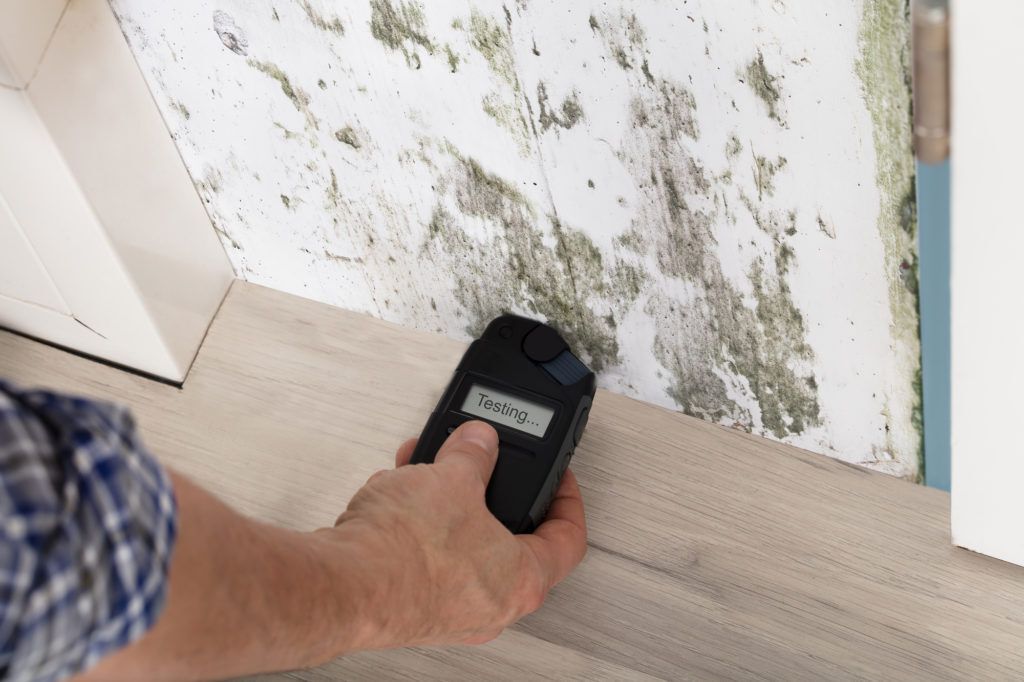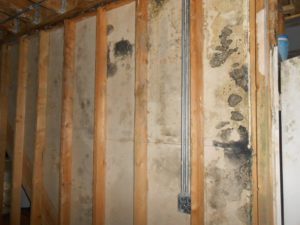Mold Inspection, Testing & Analysis
Do you need a mold inspection?
If you suspect you have mold growing inside your home or business, it’s best to hire a professional to do a thorough inspection
What Is Mold?
Mold is a natural fungus found growing outdoors. It’s not a concern when growing outdoors. In fact, it serves a purpose: to break down leaves and other materials. If mold is growing indoors, however, it can affect your home’s structural integrity, as well as the health of everyone who lives there.
How Does Mold Grow Indoors?
Mold needs just one element in order to grow: moisture. This moisture can come from a water intrusion, from condensation, or even from excessive humidity. If you have experienced a water intrusion, or condensation is present on walls, windows or other surfaces, you need to ensure that the water is dried out within 24 hours, or mold growth can occur. If your humidity is elevated, this too can lead to mold growth, and needs to be brought under control as soon as possible
These spores can cause two major problems:
Health Issues. People living in the home will breathe in the mold spores. This can lead to cold-like symptoms, including sneezing, coughing wheezing, and headaches. These symptoms will remain until the mold is removed from the environment.
Structural Issues. Mold spores are microscopic, so they can reach areas you can’t see and result in mold growing there. Behind drywall, above ceiling tiles, underneath flooring—mold will continue to grow and cause damage to the structure of the home.
There are indications that you may have mold growing inside your home. Some of these include:
You can see it. If you see mold growing on surfaces, it’s obvious you have mold. But you probably don’t know the extent of it. It could also be growing in hidden areas that you can’t see.
Musty odors. If you notice an odor that smells musty, you may have mold growth.
Humidity. If the weather is humid outdoors, it may cause excess moisture indoors. The moisture can settle on surfaces and cause condensation. If left unattended, the damp surfaces may start to grow mold.
Unexplained health issues. If you have lingering cold-like symptoms that won’t go away, it could be attributed to mold growing. Continuous exposure will make these symptoms worsen.

Mold could be making you sick, here are signs there’s mold hiding in your home
From smelling something odd to feeling sick, there are a number of different signs that can indicate that you might have mold in your house.
If you do suspect you have mold in your home, getting it taken care of as soon as you can is very important as the situation generally won’t improve over time.
If you don’t address any underlying leakage, however, you really haven’t gotten things under control — the mold will likely come back
Mold can be a common issue in homes and although it isn’t always dangerous, it can cause structural damage to the house and it can negatively impact your health when left untreated and undetected. The best thing to do if you know or suspect that there’s mold in your living area is to address the problem as soon as you can and as thoroughly as you can.
You visibly see mold spores.
Of course one of the most obvious ways to determine that you have mold in your house is if you can see it. The downside? If you see a ton of visible mold, it can be an indicator that you have a big problem on your hands.
Simply scrubbing the visible mold with soap and a sponge won’t actually get rid of the mold. So if you see visible mold, you need to reach out to a mold remediation company or another expert to help you get things under control, including any leaks that may have caused the issue in the first place.
You feel like you have a lingering cold or are battling flu-like symptoms.
If you’re dealing with symptoms that you can’t exactly pinpoint, it could be that you’re stressed, haven’t been taking care of yourself, or wound up with some sort of virus, of course, but it could also potentially be that you’re dealing with mold.

Mold Removal & Remediation
Because moldy cheese is stressful enough.
Your kids are not going to want to breath in mold for very long, and neither do you. Its critical to remove all traces of dangerous molds from your home to maintain a healthy environment, and stop the spread of bacteria. If you can see it, its already bad.
Even “dead” mold carries the same toxins and allergens as “alive” mold. But the only fix for mold is removal. When the substrate is porous (like drywall) it needs removed, and when its non-porous (like framing) we scrape, sand, and agitate it, dry, under negative pressure, to collect all the spores in an enormous HEPA filter, and get them out of your house.
Things You Should Know about Mold
Potential health effects and symptoms associated with mold exposures include allergic reactions, asthma and other respiratory complaints.
There is no practical way to eliminate all mold and mold spores in the indoor environment; the way to control indoor mold growth is to control moisture.
If mold is a problem in your home or school, you must clean up the mold and eliminate sources of moisture.
Fix the source of the water problem or leak to prevent mold growth.
Reduce indoor humidity (to 30-60%) to decrease mold growth by:
Venting bathrooms, dryers and other moisture-generating sources to the outside
Using air conditioners and de-humidifiers
Increasing ventilation
Using exhaust fans whenever cooking, dishwashing and cleaning
Clean and dry any damp or wet building materials and furnishings within 24-48 hours to prevent mold growth.
Clean mold off hard surfaces with water and detergent, and dry completely. Absorbent materials such as ceiling tiles, that are moldy, may need to be replaced.
Prevent condensation: Reduce the potential for condensation on cold surfaces (i.e., windows, piping, exterior walls, roof, or floors) by adding insulation.
In areas where there is a perpetual moisture problem, do not install carpeting (i.e., by drinking fountains, by classroom sinks, or on concrete floors with leaks or frequent condensation).
Molds can be found almost anywhere; they can grow on virtually any substance, providing moisture is present. There are molds that can grow on wood, paper, carpet, and foods.
Mold Removal from Within Your Walls: Info You Need to Know
What do we do if it’s hiding in our walls, though? Unfortunately it’s a common place for mold to grow and usually the last thing anyone wants to do is tear their walls down to resolve the issue.
What Tools Do We Need for Mold Removal?
There are quite a few tools used by experts that help us figure out whether or not you have a mold infestation within your walls. None of them include taking a sledgehammer to your walls.
Thermal Imaging Camera
One of the main tools we use in the mold inspection process is a thermal imaging camera. It has the ability to scan the room where mold is suspected and uses thermal energy to identify possible areas where mold colonies could be growing within your walls.
Moisture Meter
This brings us to our next tool—the moisture meter. This is another common tool used for mold inspection as it can show us materials in the residence or commercial facility that have high enough moisture content to grow and feed mold colonies.
Borescope
A borescope is another camera. This camera, however, is much smaller and can give us views of areas that might not be accessible to the naked eye. It’s small enough to help identify any cracks or small nooks and crannies that you might miss otherwise. This helps us with more visual inspection and helps you not have your walls torn down.